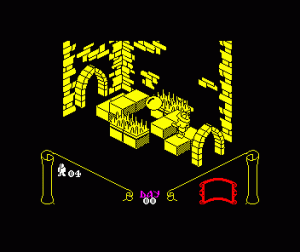111th played so far
Genre: Action
Platform: Various
Year of Release: 1984
Developer: Ultimate Play the Game
Publisher: Ultimate Play the Game
And so we dive once again into the sea of old games, this time pulling out Knight Lore, one of the hallmark games by Ultimate Play the Game, the predecessor of Rare games, one of those big names we’ve played several games of, with more coming.
Knight Lore details the ongoing life of Sabreman, an adventurer who, in this game, has been cursed with lycanthropy. He has to cure himself by running around the castle finding objects to put in a big cauldron to cure him.
As one of the first isometric platformers, this game has been a big influence – quoted to be one of the most cloned software after Wordstar (at least in this era). At the same time, it looks simple now – walk around and jump. Will it hold up?
Our Thoughts
(Due to our time becoming a bit more rare, we’ll need to change our writing a bit to make it all possible. Hence the slightly different format for this review. Lesson planning does that to your gaming time.)
This game is clearly showing its age. Not impossible to get past, but from start to finish, I felt I was playing this to play a classic, not because it was a game I’d be enjoying for the ages. I felt myself first switch-off when the instructions misspelt werewolf. As a prospective teacher I think I am in danger of becoming a bit of a grammar Nazi but this bugged me from the get go… so let’s just say I did not exactly have the best start with this game.
Let’s start with gameplay. The concept is fairly basic. You walk around in a castle, wandering from isometric room to isometric room. You have to pick up potion ingredients to cure yourself from your werewulf condition. The only tools at your disposal is that you can jump around and becoming stronger and faster when, every night, you turn into a werewolf. You have 40 days to do so, and those days pass fast. I think it is safe to estimate that you have an absolute maximum of 90 seconds between transformations.
The main problem that I had with this game was the speed of the gameplay and the fact that it change relative to how many sprites there were moving on the screen at any one time/ There are rooms where it is just you and you have 4 doors to choose from. This is all well and good because there is not a severe lag between commanding your character to turn left and him actually doing so. It gets really annoying when on the next screen (possibly) you have a situation with two bubble-like enemies (The Prisoner anyone) pushing chairs around and wanting to smother you and it is so hard to time a jump. The same problem occurs with moving platform rooms where both the lag and perspective make it hard to get from A to B.
The graphics are simple – not just because of the era, but also because the game was made for a fairly low-powered console at the time, the ZX-spectrum. This means that the screens are in a single colour (and yours changes with it). While somewhat pixelly, the graphics do work well beyond this, giving you a good idea of what’s where and what it should be. The only downside is that the perspective is still fairly new for developers, making it clear that controls aren’t quite worked out yet.
What it comes down to for me is that this game has a fairly simple concept, with simple graphics and fairly few twists in mechanics – although richer than you might think at once. What it does though is create a number of puzzles that are tough – at times fiendishly difficult – perfectly suitable for the repeat gameplay to keep bashing your head against. The influences on other games are obvious… even if it takes longer to get into than I, as a spoiled gamer, am used to. You might be tempted to drop it soon, but give it fifteen minutes, and you’re hooked. That’s the strange thing about this game is that it is not an immediate grabber but I did find myself losing more time than I expected. Like many games that we now get on mobile phones I began to have the ‘one more try’ mentality when in fact I probably ended up having another twelve goes.
Final Thoughts
And there we go. In the end, our verdict seems mostly easily summarized as this being a game time has not been kind to. All its flaws – graphics, lag, lack of instruction – are because that’s how things were then and that’s how these games worked. When you play for long enough to get past this, however, there’s a simple and addictive game that would do well on something like an iPhone. Considering its influence and popularity at the time, all I can say is that it’s surprising they haven’t tried yet. Maybe one day… keep an eye out for it!

[…] played Knight Lore in the past, with similar trappings. It was okay, and Crystal Caves predates it… so in the […]
[…] genre of isometric adventures, which we’ve seen before in games like Knight Lore and Crystal Castles, had its moment in the eighties but has almost completely died out since […]
[…] always forget how long the original Game Boy stuck around for. These isometric games in the vein of Knight Lore and Fairlight belong, in my mind, in the eighties, but Monster Max shows the genre survived into […]